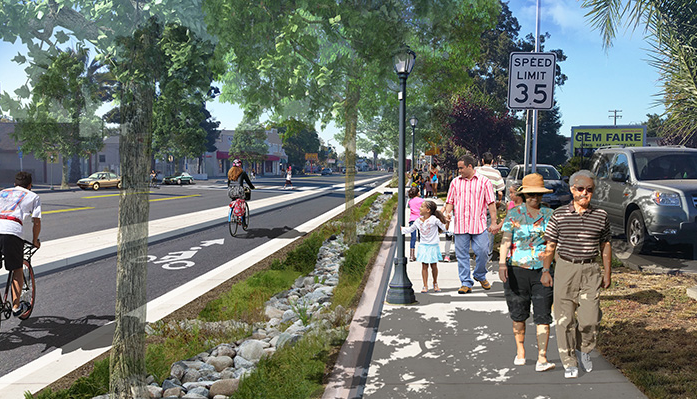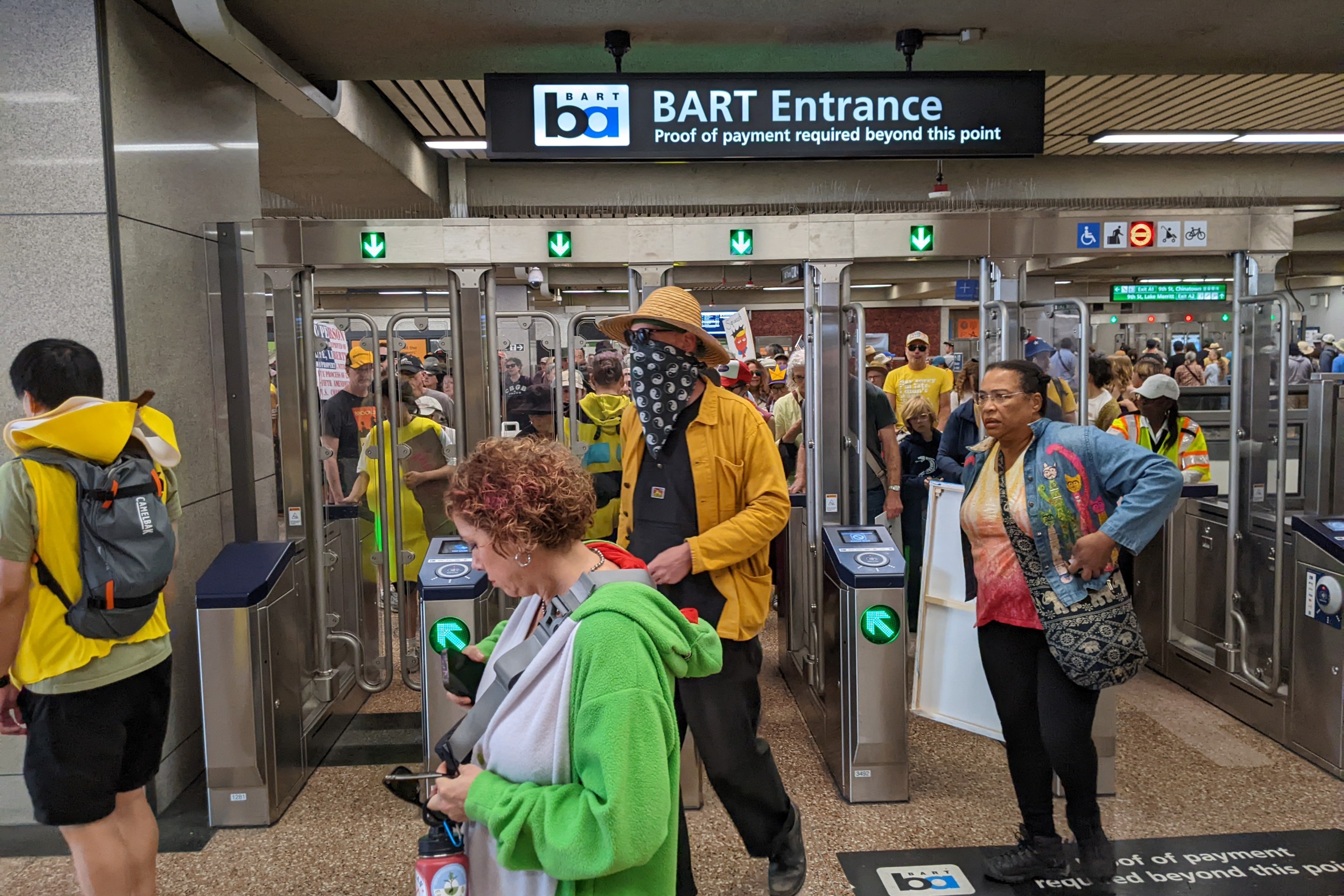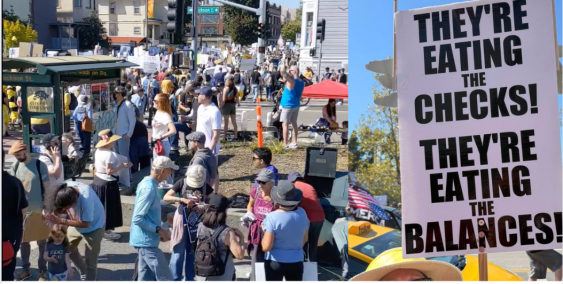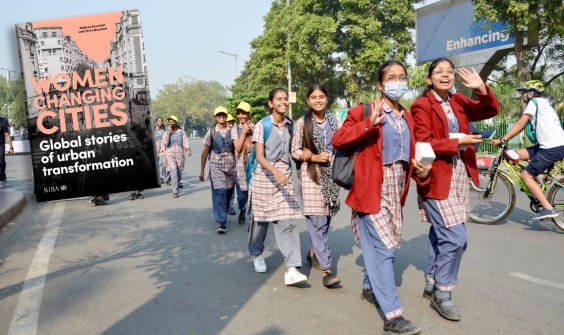Caltrans has officially issued its new Complete Streets policy, just in time for the holidays. While department personnel are not ready to answer detailed questions yet, the policy itself is publicly available [PDF] and in many ways speaks for itself.
The policy, signed by director Toks Omishakin on December 7, states that "Caltrans recognizes that streets are not only used for transportation but are also valuable community spaces. Accordingly, in locations with current and/or future pedestrian, bicycle, or transit needs, all transportation projects funded or overseen by Caltrans will provide comfortable, convenient, and connected complete streets facilities for people walking, biking, and taking transit or passenger rail unless an exception is documented and approved. When decisions are made not to include complete streets elements in capital and maintenance projects, the justification will be documented with final approval by the responsible District Director."
Caltrans already had a Complete Streets policy, issued in 2014 [PDF]. While the intent of the older policy was similar - to provide safety for walkers and bike riders on state roads - it was soft on specifics, and seemed to outline future ambitions rather than current goals.
The future may be here, with the new policy. It comes from the top this time, signed by the Caltrans Director, whereas the previous one was issued by Deputy Director Kome Ajise. It is also accompanied by a list of "high-priority implementation actions" [PDF] which include developing detailed design guidance and "championing" design flexibility to teach its engineers "state-of-the-art" street safety design principles.
One thing the list reveals is that Caltrans is still taking the first steps towards truly incorporating Complete Streets into its projects, despite years of talking about it. For example, one high-priority action is to "develop [a] process for... for tracking the inclusion of complete streets elements in Major Highway Maintenance (Pavement and Bridge) projects."
Note, however, that this action's target completion date is this coming summer - and that may be the biggest difference between the old and new policies. That is, although the "processes for tracking" are not yet developed, the background work to set them up is underway, including retraining programs for engineers and tracking pedestrian safety data such as high-injury hot spots.
As previously reported, this policy "turns the exception process on its head," as California Bicycle Coalition Director Dave Snyder put it. "They used to have to 'consider' [the needs of walkers and bike riders]," said Dave Snyder, Executive Director of the California Bicycle Coalition. "Now they have to include it."
"This changes the default to one where connected facilities for all ages and abilities are automatically included," said Warren Wells, Policy and Planning Director of the Marin County Bicycle Coalition. Engineers and planners "need to seek approval, including justification, for why they can't do so," rather than the other way around.
That is, Complete Streets "on all transportation projects funded or overseen by Caltrans" become the default, and an exception must be documented and approved if a project does not include "comfortable, convenient, and connected" facilities for people outside of vehicles.
Also note that this goes beyond safety, which is already supposed to be Caltrans' prime directive, and recognizes that "comfort, convenience, and connection" are important to allow people to opt out of driving if they wish.
The new policy states, unequivocally, that the priority of the state transportation department is "to encourage and maximize walking, biking, transit, and passenger rail" for all kinds of reasons, including climate, health, equity, and environmental ones, as well as "to foster socially and economically vibrant, thriving, and resilient communities." Also, that Caltrans will allow context-appropriate design to foster and create "networks for travelers of all ages and abilities."
This is new. While in the past several years Caltrans has been moving away from its old definition as a highway-focused department, and has set bike, walking, and transit goals, this is the first clear statement that acknowledges that Caltrans is committing to accommodating all road users in every project it works on.
Every project.
Of course, exceptions can be gamed, and unsupportive District Directors could rubber stamp them. "There's not much of a public chance to appeal those decisions" once they are made, according to Snyder. However, as set up now, the exception process "requires a fair amount of openness. They have to make an exception every step of the way, and it's well documented."
Even so, "it still can make a huge difference. That is, engineers will get the word from the beginning" that they can't just ignore the needs of bicycle riders and people on foot.
This won't happen overnight. Caltrans employs thousands of engineers, and although it is actively engaged in training them to think about safety in a more holistic way than just focused on cars, and keeping people out of the way of cars, there are still many of them who don't know how to design a safe streets facility - and many who believe that slapping down a sharrow fulfills their multimodal duties.
"There's going to be a lot of learning to do," as Wells put it.
There are more unanswered questions. For example, what counts as a "Complete Street"? Snyder points out that Caltrans' bikeway selection guide still includes high-stress facilities such as bike lanes striped on busy streets as "preferred" in some cases. And Caltrans engineers are still slapping down sharrows on 30-mph roads and calling them "bike facilities."
Then there is the question of how the policy will affect planned projects. Will changes be made in projects that are close to being built (that is, that are planned in the next few years)?
Wells wondered, for example, whether it might help a long-planned repaving project on Highway 1 north of Stinson Beach, where the Marin County Bike Coalition had tried for years to get engineers to add bike pullouts along this narrow but fast road. They did not succeed, leaving this route without any safety features for bike riders who may be brave enough to use it. The project is almost fully designed and nearing construction, but has not yet been built. Is it possible that this new Complete Streets policy could be used to get those minimal accommodations added?
The there are a lot of other projects in earlier stages that should benefit from this policy. For another Marin County example, many bike and pedestrian facilities have to cross Highway 101, the main north-south route in the county. San Rafael is considering improving a highway crossing at Manuel T. Freitas Parkway, near Northgate Mall. That project has just kicked off, and while it "looks pretty good," said Wells, "it doesn't quite meet the standard set by this policy directive. It will be interesting to see how we can use that policy on a project that's in the early stages."
It should be possible, but may take vigorous advocacy anyway. The policy notes that "opportunities for complete streets exist in all phases of project development from planning and design to construction, operations, and maintenance."
Other notable quotes from the new policy:
Caltrans recognizes that streets are not only used for transportation but are also valuable community spaces.
Complete streets shift the focus of transportation planning and project development from vehicle movement as the primary goal to the movement of people and goods.
Complete streets projects should prioritize underserved communities that have been historically harmed and segmented by the transportation network and should serve people of all ages and abilities.
The "all ages and abilities" concept strives to serve all users-regardless of age, gender, race, or ability and inclusive of the mobility needs of children, older adults, and people with disabilities-by embodying national and international best practices related to traffic calming, speed reduction, universal design, and roadway design to increase user safety and comfort, as well as accessibility for people with disabilities.
A connected multimodal network allows people to travel by whichever mode they choose and provides convenient, accessible connections between different modes.
The policy applies to the entire state transportation network, which "refers to the State Highway System (SHS) and all other multimodal facilities, including parallel and intersecting paths, frontage roads, and other facilities not directly on the SHS mainline."
It also applies to all Caltrans employees, and includes a breakdown of specific responsibilities for all employee functions, at both headquarters and in the twelve districts, including planning, project delivery, maintenance, traffic operations, safety programs, equipment, asset management, local assistance (where Caltrans partners with local agencies and jurisdictions), legal teams, and district complete streets coordinators.
For example, maintenance of "complete streets facilities" must have the same priority and meet the same standards as for driver facilities. Also, traffic operations employees must follow standards and specifications "for temporary pedestrian, bicycle, and transit access routes during construction."
Does this mean no more "lane closed" signs smack dab in the middle of the bike lane?






